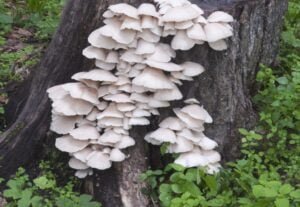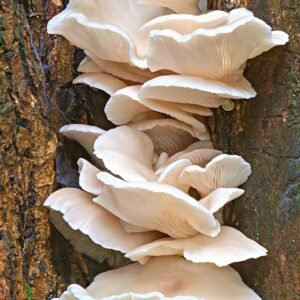The Phoenix Oyster Pleurotus Pulmonarias
You’ve probably heard of the Phaeasant oyster, Phoenix oyster, and the Pearl oyster mushroom. But what are these creatures and what are their benefits? Read on to learn more. Also read about the Pearl oyster mushroom, Pleurotus ostreatus, and the Phaeasant oyster mushroom.
Buy A Phoenix Oyster Mushroom Grow Kit Today
Phaeasant oyster
The Phoenix oyster Pleurotus pulmonarius, or grey oyster mushroom, is a beneficial food source for many people. This type of mushroom grows well on petri plates, grain, or cellulose-based substrates, and is used for a variety of medicinal purposes. However, there are several cautions that should be noted when consuming this type of food.
Harvesting logs is best done in the fall or winter months. The ideal log size is four inches (10 cm) in diameter, and 36 to 40 inches (90-100 inches) long. If you do not have logs that are the perfect size, wait at least 2 weeks before inoculating them. Waiting longer than this will increase the risk of contamination and can also cause the logs to lose moisture. However, if you cannot find any logs, you can always purchase phoenix oyster spawn plugs online.
This mushroom is similar to the Pearl oyster mushroom, but it is smaller and paler in color. It may also grow in winter, but it prefers warmer climates. In the wild, it is sometimes difficult to differentiate between the two.

Phoenix Oyster
The Phoenix Oyster (Pleurotus pulmonarias) is a popular gourmet mushroom that grows easily at home. It is similar to the Pearl oyster in appearance and is a lighter, less woody variety. The fungus is most commonly found on hardwood trees and is widely cultivated in North America and Europe.
Despite the similar appearance, this species is different from Pleurotus ostreatus. It is paler and thinner, and it prefers warmer climates. It is often confused with Pleurotus sajor-caju, but these two are different species.
The Phoenix Oyster is a versatile mushroom that can grow on a variety of substrates. This makes it a great choice for beginner mushroom cultivation and is often the first mushroom to be harvested. It decays quickly when picked, so it should be consumed within a few days of harvest.
While phoenix oyster mushrooms are easy to grow and harvest, temperature control is an important factor. The optimal temperature range is 60 to 80 degF and 18 to 27degC. If you keep your growing medium at these temperatures, you will be able to harvest the mushrooms in 14 days. In some cases, you may need to place them in a mushroom fruiting chamber to avoid adverse weather conditions.
Check Out Our Phoenix Oyster Mushroom Spawn
Pearl oyster mushroom
The Phoenix Oyster mushroom is one of the most widely available wild mushrooms. It is found throughout Europe, Asia, and North America. This mushroom is easily grown and has a high nutritional value. Its fruiting season is April through September. This mushroom is similar to the more familiar Pleurotus ostreatus.
This mushroom usually grows on hardwood trees but can also grow on conifers. Its growth rate depends on the size of the tree and the available space. Generally, this mushroom is harvested at a temperature of 18-28°C. It has a Biological Efficiency of 100-200 %.
Studies have shown that Pleurotus pulmonarius extracts have anti-cancer effects. These compounds inhibit angiotensin converting enzyme (ACE). This enzyme is responsible for constriction of the arteries. Drugs that inhibit ACE are currently being developed by the pharmaceutical industry. This mushroom has been shown to have antioxidant effects. Its polysaccharide-protein complex has been found to reduce cancer cell proliferation and inhibit cancer cell invasion.
Pleurotus ostreatus
The Phoenix Oyster is a type of mushroom. It grows in a variety of habitats, including forests, grasslands, and fields. Its cap is rounded and wide, ranging in size from about two to ten inches (5 to 25 centimeters) in diameter. The mushroom’s cap has off-center scalloped edges, and its flesh is white to cream in color.
This fungus grows well on many trees, including sugar maple, trembling aspen, and cottonwood. Its growth is influenced by the type of tree and available space. The Phoenix oyster mushroom often grows in clusters, or in rosette-like formations.
This mushroom has two main morphological differences compared to other oysters: P. populinus has a larger cap, while P. ostreatus has a smaller cap and a more pronounced stem structure. The latter is the more common type.
Phaeasant oyster mushroom
The Phoenix Oyster is a wild mushroom from the Carolinas. Its fruitbodies are white with lilac spore prints. It is similar to the pearl oyster, except it grows in warmer climates. It prefers hardwood trees, but can fruit on conifer wood. Interestingly, it has been found to have high activity in breaking down herbicides.
The Phoenix oyster is known for its analgesic and anti-inflammatory properties. It differs from the common Pleurotus ostreatus, which grows on soft substrates. It grows on BFR vermiculite cakes, straw logs, or hardwood substrates and is best cultivated between 14 and 24 degrees Celsius. For growing this mushroom, you will need liquid culture syrup, which is a mixture of water and basic sugars. This tech is suitable for both experienced and beginning mushroom growers.
Oyster mushrooms are edible. They were first cultivated in Germany during World War I, and are now grown commercially throughout the world. Similar to the king oyster, they can also be used in mycoremediation, which is a process used to break down wood and petroleum products.
Try Our Phoenix Oyster Mushroom Ready to Fruit Blocks Now
Phaeasant oyster mushroom growing kit

If you’re interested in growing your own mushrooms, you may be wondering how to successfully grow the Phoenix oyster, or “Indian Oyster” as it is commonly known. This mushroom is easy to cultivate at home and is commonly grown commercially. They are light-grey to white in color and feature a trumpet-like shape. They are best picked young, as their flesh gets tough and bitter as they mature. This mushroom has anti-oxidant properties, making it a great choice for home growers.
Unlike many mushroom varieties, the phoenix oyster requires a lot less care than some other types of mushrooms. This mushroom is very easy to grow, and can be harvested within a week or two. It has a mild flavor, with earthy undertones. Some people even detect a hint of seafood.
The Phoenix oyster is similar to the Pearl oyster, but its cap is smaller and lighter in color. It can be difficult to distinguish between the two, especially when in the wild. Nonetheless, they are both edible.
Proper lighting is an essential part of growing mushrooms, especially if you’re growing the Phoenix Oyster. You should select a light source that’s at least 50 percent full, and provide plenty of fresh air for the mushrooms to thrive. Phoenix oysters are similar to pearl oysters, though their caps are paler and their stems are longer. They prefer warmer temperatures and are usually harvested in late spring or early fall.
Phoenix oyster mushrooms grow in the same location year after year. Their growth depends on the environment, such as humidity, light, and temperature. They usually form clusters of shelf-like fruit bodies, but they can also grow singly. When grown outdoors, these mushrooms grow on decomposing stumps and logs.
Phoenix Oyster mushrooms grow best in warm climates and are easy to cultivate at home. Their white fruitbodies and spore prints are indicative of their preference for warmer climates. They prefer conifer wood, but will grow on other types of wood. In the wild, they will even convert piles of conifer mulch into soil. They’re a good choice for warmer climates and for beginner mushroom growers.
Humidity
The Phoenix Oyster, Pleurotus pulmonarias, grows best in moderate humidity and a temperature range of 12-24 degrees Celsius. This species has anti-inflammatory and cholesterol-lowering properties. The mushrooms contain various important nutrients, including antioxidants, b-glucan, and fiber. They are also high in copper and potassium.
The best time to harvest logs for mushroom cultivation is fall or winter. They should be 4 inches (10 cm) in diameter and about 36 to 40 inches (90-100 inches) long. Before inoculating, logs should rest for about two weeks. Waiting longer will increase the risk of contamination. It may also cause the logs to lose moisture. To increase the chance of success, you can also buy pre-cut plugs.
Another type of cancer is leukaemia, a disease of the blood and bone marrow. Pleurotus pulmonarius extracts have shown to inhibit leukaemia cells. These cancer cells also expressed high levels of galectin-3, a protein important for adhesion and the progression of cancer cells.
We Have Only The Best Phoenix Oyster Mushroom Liquid Culture Available
